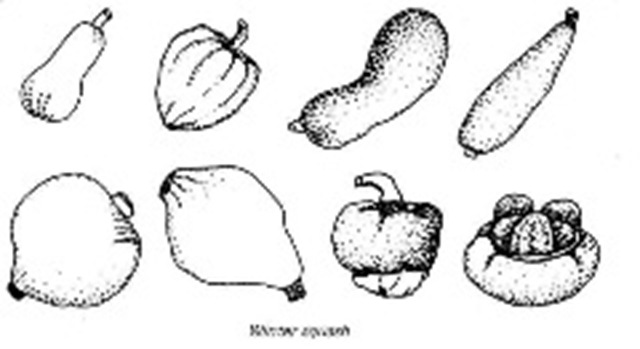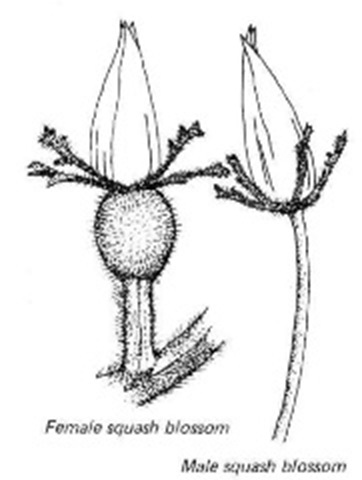Common names: acorn, banana, buttercup, butternut, cushaw, delicious, hubbard, spaghetti, Turk’s turban
Botanical name: Cucurbita species
Origin: American tropics
Varieties
Not every type of winter squash has specific recommended varieties. These are some of the varieties available; ask your Cooperative Extension Service for other specific recommendations for your area. Acorn: Ebony (80 days); Table Ace (85 days); Table King (bush-type, 85 days). Butternut: Waltham (95 days); Butterbush (small-fruited bush, 90days); Hercules (95 days). Delicious: Golden Delicious (100 days). Hubbard: Kinred (100 days); Blue Hubbard (100 days).
Description
The cucumber family, to which squashes belong, probably has the greatest diversity of shapes and sizes of any vegetable family, except the cabbages. It’s the genus Cucurbita, and includes certain gourds, and pumpkins, as well as squashes. Most are trailing or climbing plants with large yellow flowers (both male and female); the mature fruits have a thick skin and a definite seed cavity. “Summer squash,” “winter squash,” and “pumpkin” are not definite botanical names. “Pumpkin,” which any child can tell you is a large vegetable used for jack-o’-lanterns and pies, is applied to long-keeping varieties of C. moschata, C. pepo, and a few varieties of C. maxima. Summer squashes are eaten when they are immature;

winter squashes are eaten when mature. Squashes are hard to confine. A bush-type squash will grow well in a tire planter if kept well-watered and fertilized; a vining squash can be trained up a fence.
Gourds are a close relation of squash. They’re warm-season vining crops that are grown primarily for decorative uses; you can also make cooking utensils out of them, and some of them can be eaten when immature. They have the same growing requirements as winter squash, and they’re harvested in fall when the shells are hard and glossy. The importance of the gourd was recognized by Henri Christophe, who fought in the American Revolution under Lafayette and was a leader of the slave revolt in Haiti in the early 19th century. As Henry I, he used gourds as a medium of exchange, and Haitian currency is still called gourde, which is also Louisiana slang for a dollar.
Winter squashes are weak-stemmed, tender annuals, with large, cucumberlike leaves and separate male and female flowers that appear on the same plant. Most winter squashes grow as vines, although some modern varieties have been bred to have a more compact, bushy habit of growth. Winter squash varieties have hard skins when they’re harvested and eaten. Popular types of winter squash include hubbard, butternut, acorn, delicious, banana, Turk’s turban, buttercup, and cushaw. Spaghetti squash is technically a small pumpkin and is planted and cared for like pumpkins. Vining types of winter squash can be caged or trained to climb up a fence or trellis to save space. If you’re growing a variety that will

need support, set the support in place at the time of planting. If you do It later, you risk damaging the plants’ roots.
Where and when to grow
Squashes are warm-season crops and very sensitive to cold and frost. They like night temperatures of at least 60°F. Don’t plant the seeds until the soil has warmed up in spring, about two to three weeks after the average date of last frost for your area. Direct-seeding is best for squashes, but if you’re planting a variety that requires a longer growing season than your area can provide, use transplants from a reputable nursery or garden center, or grow your own. To grow your own transplants, start four to five weeks before your outdoor planting date, and use individual plantable containers to lessen the risk of shock when the seedlings are transplanted. Make sure that the plantable

Squash seedling
containers are large enough for the variety of squash you’re planting.
How to plant
Squash varieties like well-worked soil with good drainage. They’re heAavy feeders, so the soil must be well-fertilized. When you’re preparing the soil for planting, work in a complete, well-balanced fertilizer at the rate of one pound per 100 square feet or 10 pounds per 1,000 square feet. Two to three weeks after your area’s average date of last frost, when the soil is warm, plant squash in inverted hills. Make inverted hills by removing an inch of soil from an area about 12 inches across and using this soil to form a ring around the circle. Make the inverted hills three to four feet apart, and plant four or five seeds in each one. When the seedlings are large enough to handle, thin them to leave the two or three strongest young plants standing. Cut the thinned seedlings off at soil level with scissors; if you pull them out you’ll disturb the roots of the remaining seedlings.
Fertilizing and watering
Fertilize before planting and again at midseason, at the same rate as the rest of the garden. Detailed information on fertilizing is given in “Spadework: The Essential Soil” in Part 1.Keep the soil evenly moist; squashes need a lot of water in hot weather. The vines may wilt on hot days because the plant is using water faster than the roots can supply; if the vines are getting a regular supply of water, don’t worry about the wilting — the plants will liven up as the day gets cooler, if squash vines are wilting first thing in the morning, water them immediately.
Special handling
If you grow squashes indoors or in an area where there are no insects to pollinate the female flowers — your51st-fioor balcony, for instance — you may need to pollinate the flowers yourself. Take a soft-bristled brush and dust the inside of a male flower

(the one without an immature fruit on the stem), then carefully dust the inside of the female flowers.
Pests
Squash bugs, squash borers, and cucumber beetles are the major pests that squash plants attract. They don’t usually show up until you have a good harvest, so squash is still a good choice for the organic gardener. Squashes are prolific, so you can afford to lose a few of your crop to the bugs. Beetles can often be controlled by hand-picking or hosing them off the plants. Control them chemically with carbaryl. To control borers, apply carbaryl to the crowns of the plants at weekly intervals. Do this as soon as there’s any suspicion of damage — once the borers get inside the plants, chemical controls are ineffective. If a small hole in the stem tells you borers are already inside, you may still be able to save the plant. Slit the stem, remove the borers, and dispose of them. Then cover the area with soil to encourage root development at that point. Detailed information on pest control is given in “Keeping Your Garden Healthy” in Part 1.
Diseases
Squashes are susceptible to bacterial wilt, mosaic virus, and mildew. Planting disease-resistant varieties when they’re available and maintaining the general cleanliness and health of your garden will help lessen the incidence of disease. When watering, try to keep water off foliage, and don’t handle the plants when they’re wet — this can cause powdery mildew and spread disease. If a plant does become infected, remove and destroy it before it can spread disease to healthy plants. Detailed information on disease prevention is given in “Keeping Your Garden Healthy” in Part 1.
When and how to harvest
Leave winter squashes on the vine until the skin is so hard that it cannot be dented with your thumbnail, but harvest before the first frost. Break it off the vine, or cut it off with a knife that you clean after cutting each one; if the knife is not perfectly clean, it can spread disease to other plants.
Storing and preserving
Cure squashes in a dark, humid place for 10 days at 80° to 85°F; then store them at 50° to 60°F in a moderately dry, dark place for five to six months. Winter squashes can also be frozen or dried, and the seeds can be sprouted. Detailed information on storing and preserving is given in Part 3.
Serving suggestions
Winter squashes lend themselves to a good variety of culinary treatments and have the flexibility of adapting to both sweet and savory uses. Cut winter squashes into halves and bake them; serve them with honey or brown sugar and butter. Fill the halves with browned sausages, or mash the pulp and season well with salt and pepper. As a treat for the children, top mashed squash with marshmallow and brown it under the grill. Use the pulp of winter squash as a pie filling — it makes a pleasant change from pumpkin.
